Wide q waves in leads ii - Study guides, Class notes & Summaries
Looking for the best study guides, study notes and summaries about Wide q waves in leads ii? On this page you'll find 254 study documents about Wide q waves in leads ii.
All 254 results
Sort by
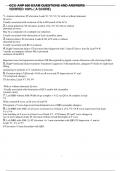 Popular
Popular
-
GCU ANP 650 EXAM QUESTIONS AND ANSWERS VERIFIED 100% ( A SCORE)
- Exam (elaborations) • 11 pages • 2023
-
- $12.99
- 2x sold
- + learn more
1. Anterior infarction: ST elevation, Leads V1, V2, V3, V4 with or without abnormal Q waves Usually associated with occlusion of the LAD branch of the LCA 2. Lateral infarction: ST elevation, Leads I, aVL, V5, V6 with or without abnormal Q waves May be a component of a multiple site infarction Usually associated with obstruction of Left circumflex artery 3. Inferior infarct: ST elevation, Leads II, III, aVF with or without abnormal Q wave Usually associated with RCA occlusion 4. Right Ven...
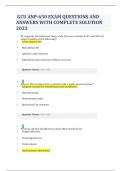 Popular
Popular
-
GCU ANP-650 EXAM QUESTIONS AND ANSWERS WITH COMPLETE SOLUTION 2023
- Exam (elaborations) • 29 pages • 2023 Popular
-
- $12.99
- 1x sold
- + learn more
GCU ANP-650 EXAM QUESTIONS AND ANSWERS WITH COMPLETE SOLUTION 2023 ST-segment elevation and deep, wide Q waves in leads II, III, and aVF are a sign of which of the following? • Acute inferior MI • Old inferior MI • Anterior wall ischemia • Subendocardial ischemia without necrosis • What is the treatment for a patient with a septic pressure ulcer? • Surgical consult for debridement and antibiotics • Hydrotherapy • Debridement only • Specialized a...

-
AIR METHODS PRE-HIRE EXAM WITH COMPLETE SOLUTIONS
- Exam (elaborations) • 29 pages • 2023
- Available in package deal
-
- $13.99
- 9x sold
- + learn more
ST elevation is associated with - ANSWER-myocardial injury ST depressions is associated with - ANSWER-Ischemia, old infarction, digitalis toxicity Q wave with ST elevation - ANSWER-Acute injury Q wave with ST depression - ANSWER-Indeterminate Q wave without ST changes - ANSWER-Old infarction Coronary Artery Occlusion: Anterior - ANSWER-LAD Coronary Artery Occlusion: Inferior - ANSWER-RCA Coronary Artery Occlusion: Posterior - ANSWER-LCX or RCA Coronary Artery Occlusion: L...
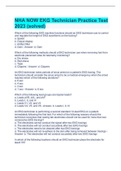
-
NHA NOW EKG Technician Practice Test 2023 (solved)
- Exam (elaborations) • 17 pages • 2023
- Available in package deal
-
- $12.99
- 3x sold
- + learn more
Which of the following EKG machine functions should an EKG technician use to control and regulate the height of EKG waveforms on the tracing? a. Speed b. Output display c. Artifact filter d. Gain - Answer- d. Gain Which of the following methods should a EKG technician use when removing hair from electrode placement sites for telemetry monitoring? a. Dry shave b. Wet shave c. Tape d. Clippers - Answer- d. Clippers An EKG technician notes periods of sinus arrest on a patient's EKG t...
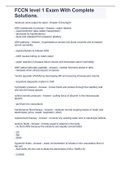
-
FCCN level 1 Exam With Complete Solutions.
- Exam (elaborations) • 13 pages • 2022
-
- $13.99
- 6x sold
- + learn more
minimum urine output for adult 0.5mL/kg/hr ADH (antidiuretic hormone) - water retainer - vasoconstrictor (also called Vasopressin) - produced by hypothalamus - store and released from posterior pituitary ADH pathway - hypothalamus senses low blood volumed and increased serum osmolality - signal pituitary to release ADH - ADH causes kidney to retain water - water retention increases blood volume and decreases serum osmolality ANP (atrial natriuretic peptide) -...
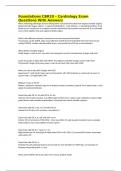
-
Foundations CBR20 – Cardiology Exam Questions With Answers
- Exam (elaborations) • 25 pages • 2024
-
- $10.59
- + learn more
Foundations CBR20 – Cardiology Exam Questions With Answers What underlying pathologic process distinguishes myocardial infarction from angina/unstable angina? Atherosclerotic plaque rupture → exposed endothelium → clot attaches → reduced blood flow; if cell death occurs (usually due to complete vascular obstruction) then positive trop and MI; if no cell death occurs then negative trop and angina/unstable angina What is the difference between transmural and non-transmural infarctio...

-
CEN Sample Test Questions and Answers Updated 2024
- Exam (elaborations) • 28 pages • 2024
- Available in package deal
-
- $15.49
- + learn more
Right ventricular infarction (RVI) lead changes - II, III, AVF R ventricular infarction s/s - clear breath sounds, hypotension, JVD. R ventricular dilation and dec contractility>> dec preload and CO Reperfusion therapy standard - Within 60 min of ED arrival Common causes of PEA - Hypoxia, tension pneumo, cardiac tamponade BNP as a marker - of L ventricular dysfunction bc ventricles make BNP and an inc of over 100 pg/ml indicates symptomatic HF Transcutaneous pacing (TCP) - ...
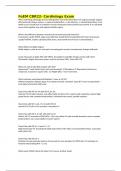
-
FoEM CBR22- Cardiology Exam
- Exam (elaborations) • 13 pages • 2024
-
- $10.59
- + learn more
FoEM CBR22- Cardiology Exam What underlying pathologic process distinguishes myocardial infarction from angina/unstable angina? Atherosclerotic plaque rupture → exposed endothelium → clot attaches → reduced blood flow; if cell death occurs (usually due to complete vascular obstruction) then positive trop and MI; if no cell death occurs then negative trop and angina/unstable angina. What is the difference between transmural and nontransmural infarction? Transmural: usually STEMI, la...
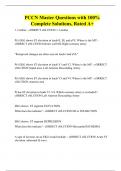
-
PCCN Master Questions with 100% Complete Solutions, Rated A+
- Exam (elaborations) • 40 pages • 2024
-
- $13.99
- + learn more
1. Cardiac - cORRECT sOLUTION 1. Cardiac Pt's EKG shows ST elevation in leads II, III, and aVF. Where is the MI? - cORRECT sOLUTION Inferior wall MI, Right coronary artery "Reciprocal changes are often seen ini leads I and aVL" Pt's EKG shows ST elevation in leads V1 and V2. Where is the MI? - cORRECT sOLUTION Septal area, Left Anterior Descending Artery Pt's EKG shows ST elevation in leads V3 and V4. Where is the MI? - cORRECT sOLUTION Anterior area Pt has ST elevation in le...
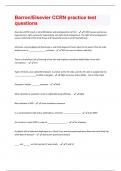
-
Barron/Elsevier CCRN practice test Questions and Answers well Explained Latest 2024/2025 Update 100% Correct.
- Exam (elaborations) • 29 pages • 2024
- Available in package deal
-
- $7.99
- + learn more
How does COPD result in atrial fibrillation and predisposition to PEs? - COPD causes pulmonary hypertension, right ventricular hypertrophy, and right atrial enlargement. The right atrial enlargement causes stretching of the atrial tissue and frequently results in atrial dysrhythmias. SA blocks, second-degree AV block type I, and third-degree AV heart block at the level of the AV node would occur in _______________ occlusion - RCA (as seen in inferior wall MIs) There is (more/less) risk of b...

$6.50 for your textbook summary multiplied by 100 fellow students... Do the math: that's a lot of money! Don't be a thief of your own wallet and start uploading yours now. Discover all about earning on Stuvia


